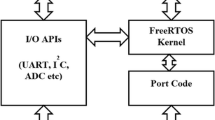Summary
In medicine and biology there are many tasks that involve routine well defined procedures. These tasks are ideal candidates for computerized data acquisition and control. As the performance of microcomputers rapidly increases and cost continues to go down the temptation to automate the laboratory becomes great. To the novice computer user the choices of hardware and software are overwhelming and sadly most of the computer sales persons are not at all familiar with real-time applications. If you want to bill your patients you have hundreds of packaged systems to choose from; however, if you want to do real-time data acquisition the choices are very limited and confusing. The purpose of this chapter is to provide the novice computer user with the basics needed to set up a real-time data acquisition system with the common microcomputers.
This chapter will cover the following issues necessary to establish a real time data acquisition and control system:
-
1.
Analysis of the research problem
-
a.
Definition of the problem
-
b.
Description of data and sampling requirements
-
c.
Cost/benefit analysis
-
2.
Choice of Microcomputer hardware and software
-
a.
Choice of microprocessor and bus structure
-
b.
Choice of operating system
-
c.
Choice of layered software
-
3.
Digital Data Acquisition
-
a.
Parallel Data Transmission
-
b.
Serial Data Transmission
-
c.
Hardware and software available
-
4.
Analog Data Acquisition
-
a.
Description of amplitude and frequency characteristics of the input signals
-
b.
Sampling theorem
-
c.
Specification of the analog to digital converter
-
d.
Hardware and software available
-
e.
Interface to the microcomputer
-
5.
Microcomputer Control
-
a.
Analog output
-
b.
Digital output
-
c.
Closed-Loop Control
-
6.
Microcomputer data acquisition and control in the 21st Century — What is in the future?
-
a.
High speed digital medical equipment networks
-
b.
Medical decision making and artificial intelligence
Similar content being viewed by others
References
Bickford RB: Automatic electroencephalographic control of general anesthesia: EEG Clin Neurophysiol 2: 93–96, 1950.
Bowman RJ, Westenskow DR: A microcomputer based fluid infusion system for the resuscitation of burn patients. IEEE trans on Biomed Eng BMD-28: (6), 1981.
Bronzino JD: Computer Applications for Patient Care. Menlo Park, Calif: Addison-Wesley Publishing Co (Medical/Nursing Div), 1982.
Coles JR, Brown WA, Lampard DG: Computer control of respiration and anaesthesia. Med Bio Eng 262–267, 1973.
Coon RL, Zuperku EJ, Kampine JP: Systemic arterial blood pH servocontrol of mechanical ventilation. Anesthesiology 49: 201–204, 1978.
East TD, Westenskow DR, Pace NL, Nelson LD: A microcomputer based differential lung ventilation system. IEEE trans Bioeng 29: 736–740, 1982.
East TD, Andriano KP, Pace NL, Westenskow DR: Computer Controlled PEEP Optimization. Crit Care Med Vol 13: 4 pp 357, 1985.
Eden HS, Eden, M: Microcomputers in Patient Care. Park Ridge, NJ: Noyes Medical Publications, 1981.
Frumin MJ, Lee ASJ: A physiologically oriented artificial respirator which produces N2O-O2 anesthesia in man. J Lab Clin Med 49: 617, 1957.
Givone DD, Roesser RP: Microprocessors Microcomputers: An introduction. New York: McGraw-Hill Book Company, 1980.
Harris CJ, Billings SA (Ed): Self-tuning and adaptive control: Theory and applications. Stevenage UK: Peter Peregrinus Ltd., (IEEE Publication), 1981.
Hayes JK, Westenskow DR, East TD, Jordan WS: Computer controlled anesthesia delivery system. Med Instr 18: 224–231, 1984.
Isermann, R: Digital Control Systems. Heidelberg, West Germany: Springer-Verlag, 1981.
Kember NF: Computer Applications in Medicine. London: Edward Arnold Ltd 1982.
Koivo AJ, Larnard D, Gray R: Digital control of mean arterial blood pressure in dogs by injecting a vasodilator drug. Ann Biomed Eng 9: 185–197, 1981.
Lamneck T (ed.) 1985 Computer Compatible Directory. Digital Design Vol 14, No 12, pp 6–184, 1984.
Linkens DA, Asbury AJ, Rimmer SJ, Menad M: IEEE conference: Applications of adaptive and multivariable control. Hull 19–21, 1982.
Moritz WE, Colocousis JS, McLain P, Barnes S: Closedloop fluid resucitation for burn patients using a microprocessor. 30th ACEMB Los Angeles Hilton, 1977.
Morris P, Tatnall ML, Montgomery FJ: Controlled anaesthesia: A clinical evaluation of an approach using patient characteristics identified during uptake. Br J Anaes 55: 1065–1075, 1983.
Ohlson KB, Westenskow DR, Jordan WS: A micro-processor based feedback controller for mechanical ventilation. Ann Biomed Eng 10: 3548, 1982.
Oppenheim AV, Schafer RW: Digital Signal Processing. Englewood Cliffs, NJ: Prentice-Hall, Inc, 1975.
Oppenheim AV, Willsky AS: Signals and Systems. Englewood Cliffs, NJ: Prentice-Hall, Inc, 1983.
Sargent M, Shoemaker RL: Interfacing Microcomputers to the Real World. Reading Mass: Addison-Wesley Publishing Co, 1981.
Shepard LC: Computer Control of the infusion of vasoactive drugs. Ann Biomed Eng 8: 431–444, 1980.
Smolen V, Barile R, Carr D: Design and operation of a system for automatic feedback controlled administration of drugs. Med Device and Diagnostics Industry 1: 51–69, 1979.
Stern KS, Walker BK, Katona PG: Automated blood pressure control using a self-tuning regulator. IEEE frontiers of Eng in Health Care IEEE, 1981.
Veronis A: Microprocessors: Design and Applications. Reston, Virginia: Reston Publishing Co, Inc, 1978.
Webster, J.G. (ed), Medical Instrumentation Application and Design. Boston: Houghton Mifflin Co., 1978.
Wernick R: Evaluation of an adaptive blood pressure controller: medical teamwork by machine. AAMI 19th Annual Meeting proceedings, Washington, DC April 1984.
Westenskow DR, Meline LJ, Pace NL, Bodily NM: Sodium nitroprusside induced hypotension with computer adjustment for varying drug sensitivity. Anes Analg 63: 281, 1984.
Westenskow DR, Jordan WS, Hayes JK: Uptake of enflurance: A study of the variability between patients. Br J Anaesth 55: 595–601, 1983.
Westenskow DR, Johnson CC, Jordan WS, Gehmlich DK: Instrumentation for measuring continuous oxygen consumption of surgical patients. IEEE Trans Biomed Eng 24; 4: 331–337, 1977.
Author information
Authors and Affiliations
Rights and permissions
About this article
Cite this article
East, T.D. Microcomputer data acquisition and control. J Clin Monit Comput 3, 225–238 (1986). https://doi.org/10.1007/BF01724390
Issue Date:
DOI: https://doi.org/10.1007/BF01724390




